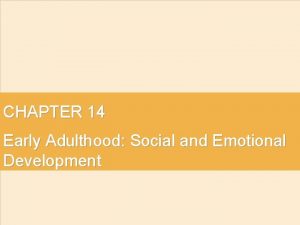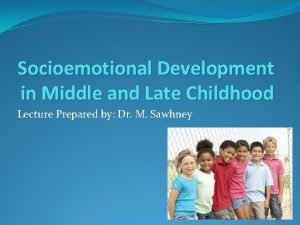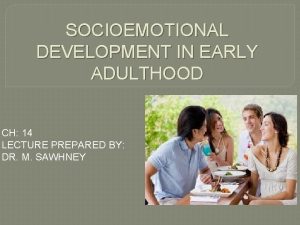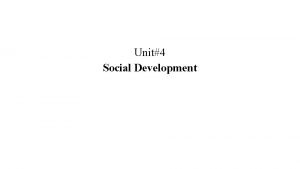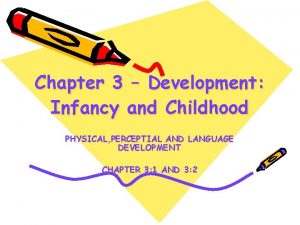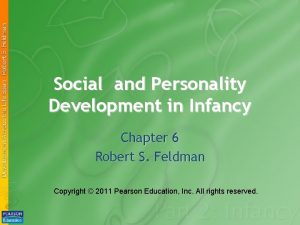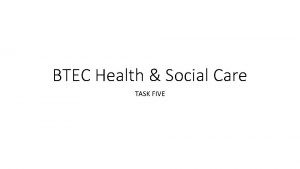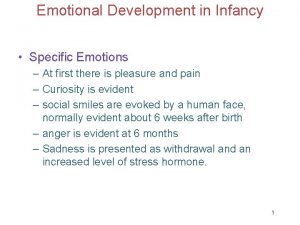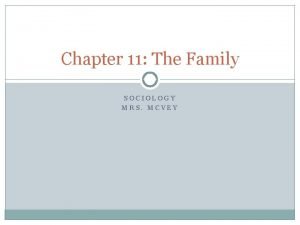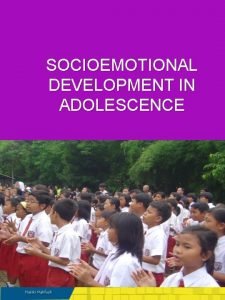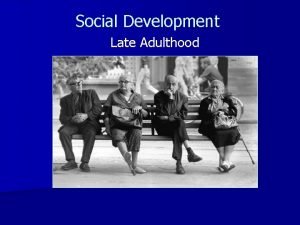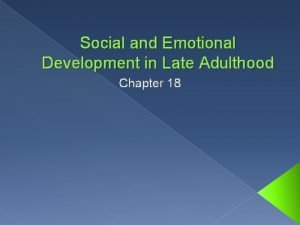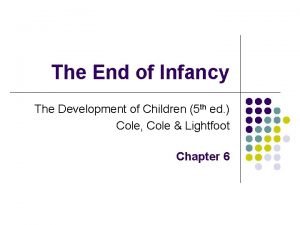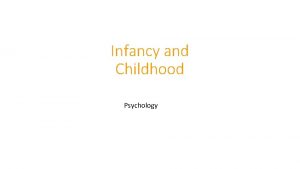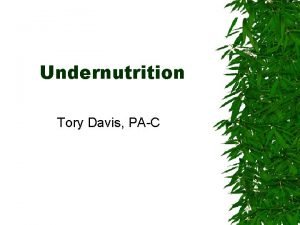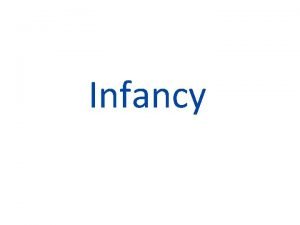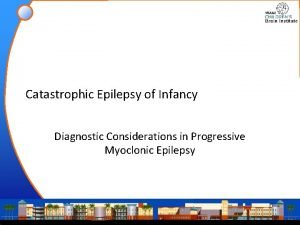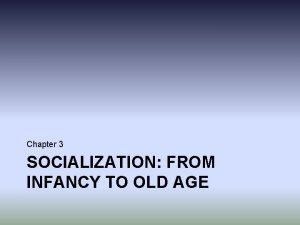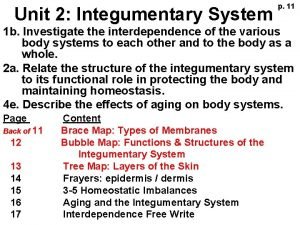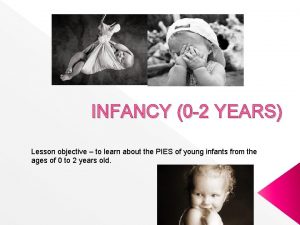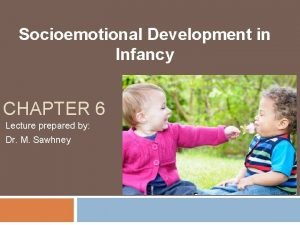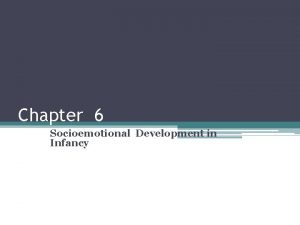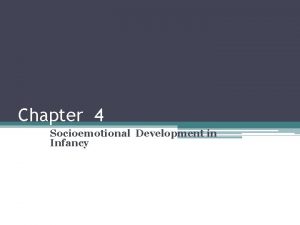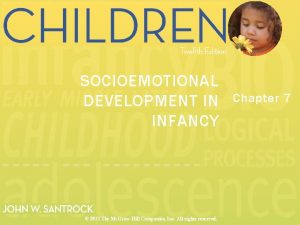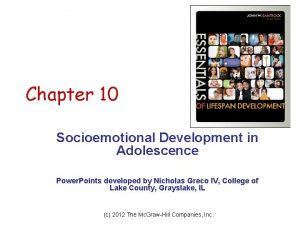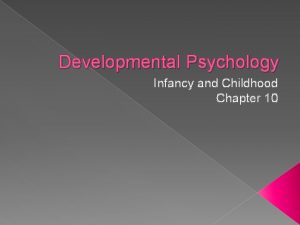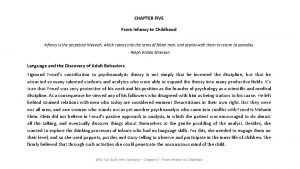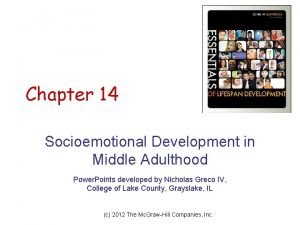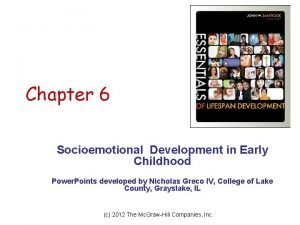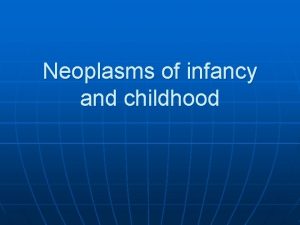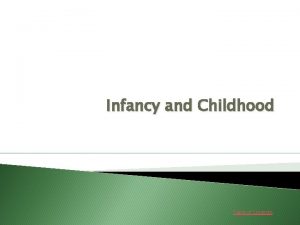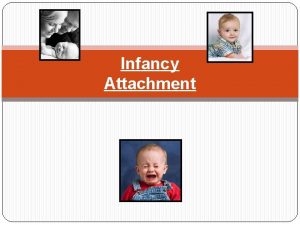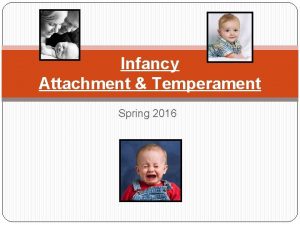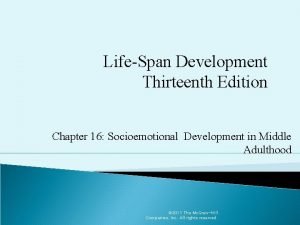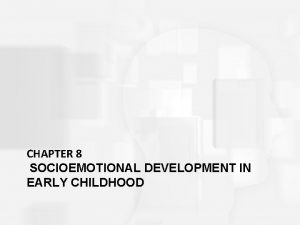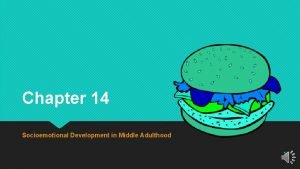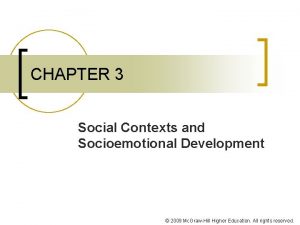Chapter 4 Socioemotional Development in Infancy Power Points







































- Slides: 39

Chapter 4 Socioemotional Development in Infancy Power. Points developed by Nicholas Greco IV, College of Lake County, Grayslake, IL (c) 2012 The Mc. Graw-Hill Companies, Inc.

What Are Emotions? § Emotion -- feeling, or affect, that occurs when a person is in a state or an interaction that is important to him or her, especially to his or her well-being § Emotions involve an individual’s communication with the world § In infancy, it is the communication aspect that is at the forefront of emotion (Campos, 2009) (c) 2012 The Mc. Graw-Hill Companies, Inc.

Classifying Emotions § Psychologists classify the broad range of emotions in many ways § Almost all classifications designate an emotion as either positive (pleasant) or negative (unpleasant) § Positive emotions include pleasant states such as happiness, joy, love, enthusiasm § Negative emotions include anxiety, anger, guilt, and sadness (c) 2012 The Mc. Graw-Hill Companies, Inc.

Biological and Environmental Influences § Emotions are influenced both by biological foundations and by a person's experience § Facial expressions of basic emotions such as happiness, surprise, anger, and fear are the same across cultures üDisplay rules—when, where, and how emotions should be expressed—are not culturally universal (Shiraev & Levy, 2010) (c) 2012 The Mc. Graw-Hill Companies, Inc.

Early Emotions § In the first six months, infants may express surprise, interest, joy, anger, sadness, fear, and disgust § Other emotions appear in the second half of the first year and by the second year üjealousy, empathy, embarrassment, pride, shame, and guilt üthese have been called self-conscious emotions or other-conscious emotions (Lewis, 2007; Saarni & others, 2006) (c) 2012 The Mc. Graw-Hill Companies, Inc.

Emotional Expressions and Relationships § Emotional expressions -- infants’ first relationships § Infants communicate emotions and this enables coordinated interactions with their caregivers § Parents change their emotional expressions in response to infants’ emotional expressions § Infants also modify their emotional expressions in response to their parents’ emotional expressions (c) 2012 The Mc. Graw-Hill Companies, Inc.

Crying § Crying -- most important mechanism newborns have for communicating § Babies have at least three types of cries: übasic cry üsome infancy experts believe that hunger is one of the conditions that incite the basic cry üanger cry üpain cry üthe pain cry may be stimulated by physical pain or by any high-intensity stimulus (c) 2012 The Mc. Graw-Hill Companies, Inc.

Should Parents Respond to an Infant’s Cries? § Many developmentalists recommend that parents soothe a crying infant, especially in the first year § This reaction should help infants develop a sense of trust and secure attachment to the caregiver (c) 2012 The Mc. Graw-Hill Companies, Inc.

Smiles § Two types of smiling can be distinguished in infants: ü Reflexive smile -- does not occur in response to external stimuli and appears during the first month after birth, usually during sleep ü Social smile -- occurs in response to an external stimulus üSocial smiling occurs as early as four months of age in response to a caregiver’s voice (Campos, 2005) (c) 2012 The Mc. Graw-Hill Companies, Inc.

Fear § Fear -- one of a baby’s earliest emotions üfirst appears at about 6 months and peaks at about 18 months üabused and neglected infants can show fear as early as 3 months üstranger anxiety -- most frequent expression of an infant’s fear üusually emerges gradually üdepends on the social context and the characteristics of the stranger (Campos, 2005; Emde, Gaensbauer, & Harmon, 1976) (c) 2012 The Mc. Graw-Hill Companies, Inc.

Frequency of Stranger Anxiety § Less stranger anxiety when they are in familiar settings § When infants feel secure, they are less likely to show stranger anxiety § Less fearful of child strangers than adult strangers § Less fearful of friendly, outgoing, smiling strangers than of passive, unsmiling strangers § Separation protest -- crying when the caregiver leaves (Bretherton, Stolberg, & Kreye, 1981) (c) 2012 The Mc. Graw-Hill Companies, Inc.

(c) 2012 The Mc. Graw-Hill Companies, Inc.

Social Referencing § Social referencing -- reading emotional cues in others to help determine how to act in a particular situation ühelps infants to interpret ambiguous situations more accurately üby the end of the first year, a parent’s facial expression influences exploration of an unfamiliar environment üsocial referencing improves in the second year of life (c) 2012 The Mc. Graw-Hill Companies, Inc.

Emotional Regulation and Coping § During the first year of life, infant develops ability to minimize the intensity and duration of emotional reactions § From early in infancy, babies put their thumbs in their mouths to self-soothe § In their second year, they may say things to themselves to help self-soothe (Eisenberg, Spinrad, & Smith, 2004) (c) 2012 The Mc. Graw-Hill Companies, Inc.

Emotional Regulation and Coping § Caregivers’ actions influence the infant’s neurobiological regulation of emotions üGood strategy to soothe an infant before the infant gets into an intense, agitated, uncontrolled state § Later in infancy, infants sometimes redirect their attention or distract themselves in order to reduce their arousal (Laible & Thompson, 2007; de Haan & Gunnar, 2009; Thompson, 2006; Grolnick, Bridges, & Connell, 1996) (c) 2012 The Mc. Graw-Hill Companies, Inc.

Contextual Adaptation § Contexts can influence emotional regulation § Often affected by fatigue, hunger, time of day, which people around them, and where they are § Must learn to adapt to different contexts (Thompson, 2010) (c) 2012 The Mc. Graw-Hill Companies, Inc.

Describing and Classifying Temperament § Researchers have described and classified the temperament of individuals in three different ways § Chess and Thomas’ Classification üEasy, difficult, and slow-to-warm-up child § Kagan’s Behavioral Inhibition üInhibition to the unfamiliar § Effortful Control (Self-Regulation) (c) 2012 The Mc. Graw-Hill Companies, Inc.

Effortful Control (Self-Regulation) § Effortful control (self-regulation) is an important dimension of temperament üInfants high on effortful control show an ability to keep their arousal from getting too high and have strategies for soothing themselves üInfants low on effortful control are often unable to control their arousal; they are easily agitated and become intensely emotional (Bates, 2008) (c) 2012 The Mc. Graw-Hill Companies, Inc.

Biological Foundations and Influences § Children inherit a physiology that biases them to have a particular type of temperament § Physiological characteristics have been linked with different temperaments § Inhibited temperament is associated with a unique physiological pattern ühigh and stable heart rate ühigh level of the hormone cortisol ühigh activity in the right frontal lobe of the brain (Kagan, 2010) (c) 2012 The Mc. Graw-Hill Companies, Inc.

Gender, Culture, and Temperament § Parents may have different reactions to temperament, depending on the sex of the baby § Reaction to temperament may depend in part on culture § Many aspects of a child’s environment can encourage or discourage the persistence of temperament characteristics ) (c) 2012 The Mc. Graw-Hill Companies, Inc.

Goodness of Fit and Implications for Parenting § Goodness of fit -- the match between temperament and the environmental demands with which child must cope § Children differ from each other very early in life üdifferences have important implications for parent-child interaction üattention to and respect for individuality üstructure the child’s environment üavoid applying negative labels to the child (Putnam, Sanson, & Rothbart, 2002) (c) 2012 The Mc. Graw-Hill Companies, Inc.

Personality Development § Personality -- the enduring personal characteristics of individuals üEmotions and temperament form key aspects § Trust üErikson -- first year of life is characterized by the trust versus mistrust stage/crisis § Identity -- sense of who they are and what makes them different from everyone else (c) 2012 The Mc. Graw-Hill Companies, Inc.

Self-Recognition § Infants begin to develop a rudimentary form of self-recognition -- being attentive and positive toward one’s image in a mirror as early as 3 months § A more complete index of self-recognition - the ability to recognize one’s physical features üemerges in the second year (Pipp, Fischer, & Jennings, 1987; Thompson, 2006) (c) 2012 The Mc. Graw-Hill Companies, Inc.

(c) 2012 The Mc. Graw-Hill Companies, Inc.

Independence § Erikson (1968) stressed that independence is an important issue in the second year of life üErikson’s second stage of development is identified as “autonomy versus shame and doubt” üautonomy builds as the infant’s mental and motor abilities develop üwhen caregivers are impatient and do for toddlers what they are capable of doing themselves, shame and doubt develop (c) 2012 The Mc. Graw-Hill Companies, Inc.

Social Orientation § Infants are captivated by the social world early in development § Face-to-face play characterizes caregiverinfant interactions at about 2 to 3 months of age § Their interaction with peers increases considerably in the latter half of the second year § Between 18 to 24 months, imitative and reciprocal play increases (c) 2012 The Mc. Graw-Hill Companies, Inc.

Attachment § Attachment -- a close emotional bond between two people § Freud theorized that infants become attached to the person or object that provides oral satisfaction § Harry Harlow’s classic study § Four phases based on Bowlby’s conceptualization of attachment üPhase 1: From birth to 2 months üPhase 2: From 2 to 7 months üPhase 3: From 7 to 24 months üPhase 4: From 24 months on (c) 2012 The Mc. Graw-Hill Companies, Inc.

Theories of Attachment § Bowlby -- belief in an internal working model of attachment üa simple mental model of the caregiver, their relationship, and the self as deserving of nurturant care § Mary Ainsworth (1979) created the Strange Situation üthe degree to which the caregiver’s presence provides the infant with security and confidence (Thompson, 2006; Ainsworth, 1979) (c) 2012 The Mc. Graw-Hill Companies, Inc.

Individual Differences in Attachment § Based on how babies respond in the Strange Situation ü securely attached babies use the caregiver as a secure base ü insecure avoidant babies show insecurity by avoiding the mother ü insecure resistant babies often cling to the caregiver and then resist fighting against the closeness ü insecure disorganized babies -- disorganized and disoriented (c) 2012 The Mc. Graw-Hill Companies, Inc.

Criticisms of Attachment Theory § Kagan and others believe that too much emphasis has been placed on the attachment bond in infancy § Jerome Kagan sees infants as highly resilient and adaptive üthey are equipped to stay on a positive developmental course § Attachment theory ignores the diversity of socializing agents and contexts in an infant’s world (Kagan, 1987, 2002) (c) 2012 The Mc. Graw-Hill Companies, Inc.

Social Contexts: The Family § A constellation of subsystems ücomplex whole made up of interrelated, interacting parts üdefined in terms of generation, gender, role üsubsystems have reciprocal influences on each other ümarital relations, parenting, and infant behavior and development can have both direct and indirect effects on each other (Jay Belsky, 1981) (c) 2012 The Mc. Graw-Hill Companies, Inc.

(c) 2012 The Mc. Graw-Hill Companies, Inc.

Reciprocal Socialization § Socialization that is bidirectional üchildren socialize parents just as parents socialize children § Scaffolding -- timing interactions so that the infant experiences turn-taking with the parents üscaffolding involves parental behavior that supports children’s efforts ücaregivers provide a positive, reciprocal framework for interaction (c) 2012 The Mc. Graw-Hill Companies, Inc.

Maternal and Paternal Caregiving § Mothers spend considerably more time in caregiving with infants and children than do fathers ü Mothers are more likely to have managerial role § Fathers have the ability to act sensitively and responsively with their infants § Typical father behaves differently toward an infant than the typical mother § Father’s presence in a child’s life is beneficial ü Leads to more success in school (Lamb, 2010; Parke & Buriel, 2006) (c) 2012 The Mc. Graw-Hill Companies, Inc.

Parental Leave § More young children are in child care than at any other time in U. S. history § U. S. adults tend not to receive paid leave to care for their young children § The United States allows up to 12 weeks of unpaid leave for parents who are caring for a newborn § The European Union has mandated a 14 week maternity leave (c) 2012 The Mc. Graw-Hill Companies, Inc.

Variations in Child Care § Factors that influence the effects of child care üthe age of the child üthe type of child care üthe quality of the program (c) 2012 The Mc. Graw-Hill Companies, Inc.

Types of Child Care § Large centers with elaborate facilities § Private homes § Commercial operations or nonprofit centers run by churches, civic groups, and employers § Child care providers vary üProfessionals üUntrained adults who want to earn extra money (c) 2012 The Mc. Graw-Hill Companies, Inc.

Quality of Care Makes a Difference § Poor-quality child care is more likely for families with few resources (psychological, social, and economic) § Extensive child care was harmful to lowincome children only when the care was of low quality § High-quality care was linked with fewer internalizing problems (e. g. , anxiety) and externalizing problems (e. g. , aggressive and destructive behaviors) (c) 2012 The Mc. Graw-Hill Companies, Inc.

Strategies to Follow in Choosing Child Care § Recognize that the quality of your parenting is a key factor in your child’s development § Make decisions that will improve the likelihood you will be good parents § Monitor your child’s development § Take some time to find the best child care (Kathleen Mc. Cartney, 2003) (c) 2012 The Mc. Graw-Hill Companies, Inc.
 Socioemotional development in infancy
Socioemotional development in infancy Chapter 5 cognitive development in infancy and toddlerhood
Chapter 5 cognitive development in infancy and toddlerhood Socioemotional development in late adulthood
Socioemotional development in late adulthood Emotional development in early adulthood
Emotional development in early adulthood Socio-emotional development of late childhood
Socio-emotional development of late childhood Socioemotional development in early adulthood
Socioemotional development in early adulthood Social development in adulthood
Social development in adulthood Social development in infancy and childhood
Social development in infancy and childhood Chapter 7 human growth and development
Chapter 7 human growth and development Module 47 infancy and childhood cognitive development
Module 47 infancy and childhood cognitive development Stages of developmetn
Stages of developmetn 6 life stages
6 life stages Infancy and childhood physical development
Infancy and childhood physical development Personality development in infancy
Personality development in infancy Infant personality development
Infant personality development Intellectual in health and social care
Intellectual in health and social care New emotions that appear toward the second year
New emotions that appear toward the second year Module 46 infancy and childhood physical development
Module 46 infancy and childhood physical development Module 47 infancy and childhood cognitive development
Module 47 infancy and childhood cognitive development Chapter 10 infancy and childhood
Chapter 10 infancy and childhood Chapter 10 infancy and childhood
Chapter 10 infancy and childhood Chapter 10 infancy and childhood
Chapter 10 infancy and childhood Socioemotional maintenance definition sociology
Socioemotional maintenance definition sociology ________ is a self-portrait composed of many pieces.
________ is a self-portrait composed of many pieces. Social development in late adulthood
Social development in late adulthood Elders' housing preferences reflect a strong desire for
Elders' housing preferences reflect a strong desire for Active power reactive power apparent power
Active power reactive power apparent power Straddle positioning example
Straddle positioning example Point of difference and point of parity
Point of difference and point of parity Infancy period
Infancy period Infancy and childhood psychology
Infancy and childhood psychology Middle childhood age
Middle childhood age Infancy
Infancy Infancy physical changes
Infancy physical changes Catastrophic epilepsy infancy
Catastrophic epilepsy infancy Lesson quiz 3-2 infancy and childhood
Lesson quiz 3-2 infancy and childhood Socialization from infancy to old age
Socialization from infancy to old age Infancy childhood adolescence adulthood old age
Infancy childhood adolescence adulthood old age Pies in infancy
Pies in infancy Pavlik harness
Pavlik harness



